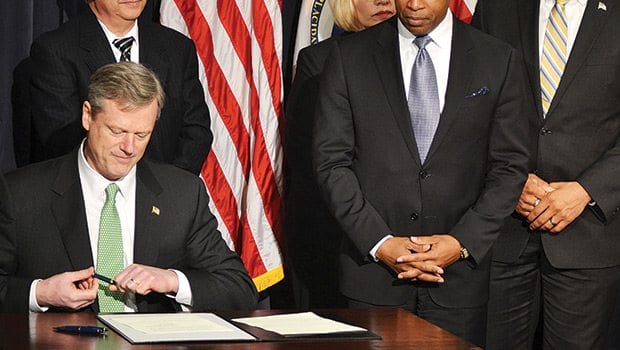Baker administration targets chronically unemployed
Task force to seek opportunities for black, Latino, veteran and disabled job seekers

By the Numbers
Under city law, both publicly funded and large privately funded construction projects are supposed to hire a construction staff comprising:
50 percent: City residents
25 percent: People of color
10 percent: Women
Six years ago, during the height of the Great Recession, it might have seemed improbable that the unemployment rate in Massachusetts would ever drop to the 4.9 percent revealed in state data released last week. But economic relief has not been felt across the board. Unemployment remains at a stubborn 7 to 12 percent for African Americans, Latinos, veterans and people with disabilities, according to data from the Governor’s Office.
That’s why Governor Charlie Baker signed an executive order last week establishing a task force on Economic Opportunity for Populations Facing Chronically High Rates of Unemployment. The task force will focus on unemployment among those four target groups.
The panel, chaired by Secretary of Labor and Workforce Development Ron Walker, includes the heads of five executive offices — Housing and Economic Development, Health and Human Services, Veterans’ Services, Education, and Access and Opportunity – as well as members from the business, non-profit, public health and education sectors appointed by the governor.
“For too long, the target populations have suffered from chronically high rates of unemployment,” Walker said in a press statement. “The task force is charged with understanding how best to reshape our public workforce system to meet the needs of the target population and how best to assist individuals in achieving their goals of meaningful employment.”
The group will meet for eight months both internally and community members to identify with challenges and develop strategies to address chronic unemployment. The task force is slated to make policy recommendations to the governor by November 15, 2015 and then disband within 30 days of presenting their ideas.
Ann Dufresne, communications director for the state’s Executive Office of Labor and Workforce Development, says the effort is unique because it is the first time a governor has brought together high-level Cabinet officials with community representatives to directly focus on the needs of the four target populations.
The task force is the latest in a series of moves by the governor aimed at addressing joblessness and increasing diversity within state government. In February, he elevated the Office of Access and Opportunity to a Cabinet-level office and created the position of deputy chief of staff to lead it. The OAO was created by former Governor Deval Patrick and previously housed within the office of Administration and Finance.
Multi-pronged strategy
Baker also signed another executive order in February establishing a Workforce Skills Cabinet with the goal of improving the general population’s preparedness for jobs in today’s economy. Secretary Walker also chairs that cabinet. The recommendations generated by the eight-month task force will inform the longer-term work of the Workforce Skills Cabinet.
In a conversation with the Banner, Walker said the Task Force would focus on ensuring people are equipped for the needs of today’s employers. He said this process would include creating more effective partnerships between employers and the state’s network of career centers, community colleges and vocational schools; examining best practices from organizations’ on-the-ground experiences to implement them on a broader scale; ensuring solutions are regionally focused to take into account the differences between communities; and building proficiency in math, reading and science with a focus on technology and STEM to ensure people have the credentials for the jobs that local employers are looking to fill.
The formal schedule for the Economic Opportunity task force’s community meetings has not yet been determined. When they are scheduled they will be publicized widely and appear on the Executive Office of Labor and Workforce Development’s website.
Dufresne says that the community partner organizations selected for the panel were chosen “based on their track record of delivering positive services and outcomes to the populations that they serve.” All task force members have been identified, although there are a few who have not yet been publicly named because they are finishing the required background check.
Open up opportunity
Former City Councilor Chuck Turner, who helped found the Greater Roxbury Workers Alliance, said the task force’s first step was to give a clear picture of the problem.
“While you’ll see anecdotal stories about joblessness, there isn’t any overall source to look at the issue,” he said.
Turner said that more specifically, the task force should do an analysis of state prisons and jails to determine the exact number of men and women returning to their communities after incarceration, as that population is unemployed by definition. He also suggested the task force look at how urban areas such as Boston, Springfield and Fall River could replicate the kind of target level requirements that currently exist for Boston construction projects within other industries as well.
Under city law, both publicly funded and large privately funded construction projects are supposed to hire a construction staff comprising 50 percent city residents, 25 percent people of color, and 10 percent women.






